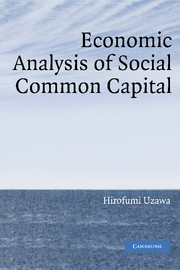Book contents
- Frontmatter
- Contents
- List of Figures
- Preface
- Introduction: Social Common Capital
- 1 Fisheries, Forestry, and Agriculture in the Theory of the Commons
- 2 The Prototype Model of Social Common Capital
- 3 Sustainability and Social Common Capital
- 4 A Commons Model of Social Common Capital
- 5 Energy and Recycling of Residual Wastes
- 6 Agriculture and Social Common Capital
- 7 Global Warming and Sustainable Development
- 8 Education as Social Common Capital
- 9 Medical Care as Social Common Capital
- Main Results Recapitulated
- References
- Index
3 - Sustainability and Social Common Capital
Published online by Cambridge University Press: 18 December 2009
- Frontmatter
- Contents
- List of Figures
- Preface
- Introduction: Social Common Capital
- 1 Fisheries, Forestry, and Agriculture in the Theory of the Commons
- 2 The Prototype Model of Social Common Capital
- 3 Sustainability and Social Common Capital
- 4 A Commons Model of Social Common Capital
- 5 Energy and Recycling of Residual Wastes
- 6 Agriculture and Social Common Capital
- 7 Global Warming and Sustainable Development
- 8 Education as Social Common Capital
- 9 Medical Care as Social Common Capital
- Main Results Recapitulated
- References
- Index
Summary
INTRODUCTION
Social common capital involves intergenerational equity and justice. Although the construction and maintenance of social common capital require the use of substantial portions of scarce resources, both human and nonhuman, putting a significant burden on the current generation, future generations will benefit greatly if the construction of social common capital carried out by the current generation is properly arranged.
In this chapter, we examine the problems of the accumulation of social common capital primarily from the viewpoint of the intergenerational distribution of utilities. Our analysis is based on the concept of sustainability introduced in Uzawa (1991b, 2003), and we examine the conditions under which processes of the accumulation of social common capital over time are sustainable. The conceptual framework of the economic analysis of social common capital developed in Chapter 2 are extended to deal with the problems of the irreversibility of processes of the accumulation of social common capital owing to the Penrose effect. The concept of the Penrose effect was originally introduced in Uzawa (1968, 1969) in the context of macroeconomic analysis, and was extensively utilized in the dynamic analysis of global warming as described in Uzawa (2003, Chapter 5). The presentation of the theory of sustainable processes of capital accumulation in this chapter largely reproduces the one introduced there.
The analysis focuses on the examination of the system of imputed prices associated with the time-path of consumption that is dynamically optimum with respect to the intertemporal preference relation, in which the presence of the Penrose effect implies the diminishing marginal rates of investment in private capital and social common capital upon the rates at which private capital and social common capital are accumulated.
- Type
- Chapter
- Information
- Economic Analysis of Social Common Capital , pp. 122 - 155Publisher: Cambridge University PressPrint publication year: 2005



